Stock Markets Retreat on Realisation that Fed Could Cut Emergency Economic Support
Stock-Markets / Financial Markets 2009 Sep 27, 2009 - 05:48 AM GMT After hitting its best levels of the year on Wednesday ahead of the Federal Open Market Committee’s (FOMC) communiqué, the S&P 500 Index ran into heavy weather on the realization that the Fed could start scaling back on emergency support of the economy. US equities dropped further later in the week on renewed concerns about the state of the troubled housing market and weaker-than-expected durable goods orders.
After hitting its best levels of the year on Wednesday ahead of the Federal Open Market Committee’s (FOMC) communiqué, the S&P 500 Index ran into heavy weather on the realization that the Fed could start scaling back on emergency support of the economy. US equities dropped further later in the week on renewed concerns about the state of the troubled housing market and weaker-than-expected durable goods orders.
In addition to global stock markets declining, risky assets such as commodities, oil, gold and other precious metals all sold off as pundits worried about the winding down of quantitative easing puncturing the “liquidity rally”. Government and corporate bonds, as well as the Japanese yen, emerged as winners.
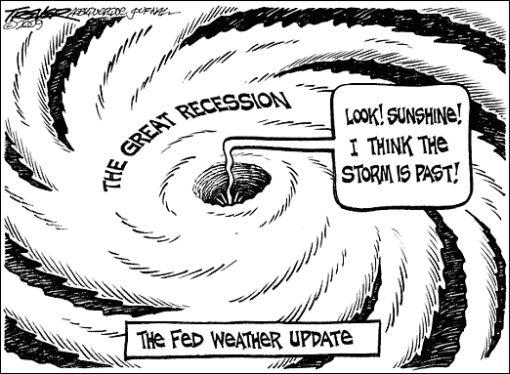
Hat tip: The Big Picture, September 23, 2009.
The FOMC maintained its loose monetary policy following its meeting on Wednesday. The statement said the committee expected to keep the Fed funds rate target in the 0% to 0.25% range “for an extended period”.
“The committee extended the time period over which it plans to purchase Fannie Mae and Freddie Mac debt and mortgage-backed securities. The remarks on current economic conditions were more optimistic than in August, and the FOMC now believes the recession is over. The Fed will keep monetary policy loose in the near term to support the recovery but is laying the groundwork for an eventual tightening,” said Moody’s Economy.com.
Although the US Dollar Index (+0.4%) closed a little higher on the week, the greenback hit a one-year low against the euro on Wednesday, with the Fed’s indication of keeping US interest rates at current levels for a while longer underscoring the dollar’s status as a carry-trade funding currency. (Click here for a short technical analysis of the outlook for the dollar by INO.com’s Adam Hewison.)
The past week’s performance of the major asset classes is summarized by the chart below - a set of numbers that shows risk aversion creeping back into financial markets.
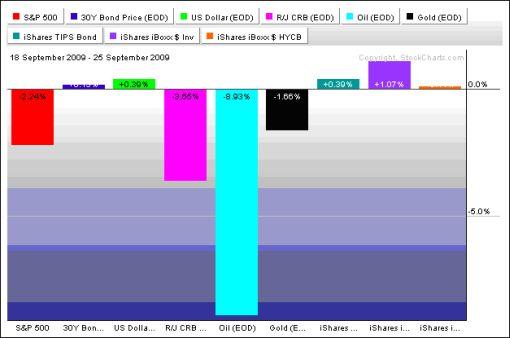
Source: StockCharts.com
A summary of the movements of major global stock markets for the past week, as well as various other measurement periods, is given in the table below.
The MSCI World Index (-1.4%) and MSCI Emerging Markets Index (-1.2%) both closed the week in the red, with the Shanghai Composite Index (-4.2%) one of the biggest losers among the major stock markets. After bucking the global weakness that prevailed during the week, Chile is now only 5.1% down from its July 2007 highs and could be one of the first markets to wipe out all the financial crisis losses.
The major US indices declined for three consecutive days (from Wednesday to Friday) and registered their first weekly drop since the last week of August. The year-to-date gains remain in positive territory and are as follows: Dow Jones Industrial Index +10.1%, S&P 500 Index +15.6%, Nasdaq Composite Index +32.6% and Russell 2000 Index +19.9%.
Click here or on the table below for a larger image.
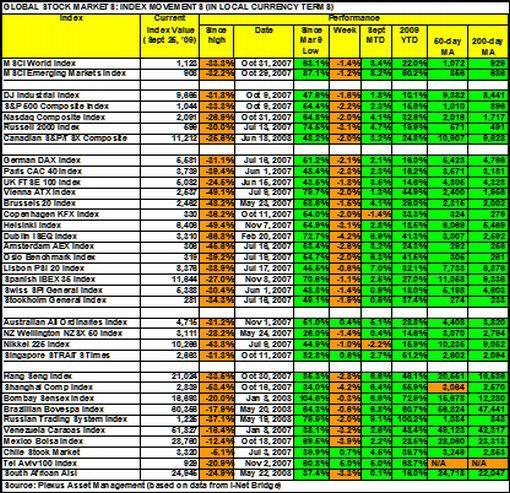
Top performers in the stock markets this week were Latvia (+8.0%), Cyprus (+6.8%), Israel (+5.0%), Ukraine (+4.9%) and Saudi Arabia (+4.1%). At the bottom end of the performance rankings, countries included Luxembourg (‑8.7%), Ireland (-4.2%), China (-4.2%), Mexico (-4.0%) and South Africa (‑3.3%).
Of the 98 stock markets I keep on my radar screen, 44% recorded gains (last week 81%), 51% (15%) showed losses and 5% (4%) remained unchanged. (Click here to access a complete list of global stock market movements, as supplied by Emerginvest.)
John Nyaradi (Wall Street Sector Selector) reports that, as far as exchange-traded funds (ETFs) are concerned, the winners for the week included Global X/InterBolsa FTSE Colombia 20 (GXG) (+6.0%), Market Vectors High-Yield Municipal (HYD) (+2.9%), iPath S&P 500 VIX Mid-Term Futures (VXZ) (+2.9%) and United States Natural Gas (UNG) (+2.8%).
At the bottom end of the performance rankings, ETFs included United States Gasoline (UGA) (-10.8%), United States Oil (USO) (-8.4%), United States 12 Month Oil (USL) (-8.3%) and iShares Dow Jones Home Construction (ITB) (‑8.3%).
Against the background of the International Monetary Fund’s approval of the sale of 403.3 metric tons of its gold and beggar-thy-neighbor currency devaluations, Richard Russell reminded us of the following quote from the Republican National Platform in 1932: “The Republican Party established and will continue to uphold the gold standard and will oppose any measure which will undermine the government’s credit or impair the integrity of our national currency. Relief by currency inflation is unsound in principle and dishonest in results.” Russell added: “My, how times have changed, and not always for the better.”
Other news is that the summit of G20 countries have agreed, inter alia, to plot a roadmap for the banking industry, align economic policy, ensure that tax havens comply with global standards and phase out subsidies for fossil fuels in the “medium term”.
Also, the Federal Deposit Insurance Corporation (FDIC) closed another bank on Friday, bringing the tally of US bank failures in 2009 to 95 (120 since the beginning of the recession). Meanwhile, according to The New York Times, regulators are considering a plan to have the nation’s healthy banks lend billions of dollars to rescue the FDIC. This would enable the fund, which is running low on resources as a result of the myriad of bank failures, to continue to rescue the sickest banks … “You can’t make up stuff like this!,” commented Bill King (The King Report).
Next, a quick textual analysis of my week’s reading. Although “banks” still features prominently, the key words have started taking on a more normal pattern compared with the crisis-related words that have dominated the tag cloud for many months.
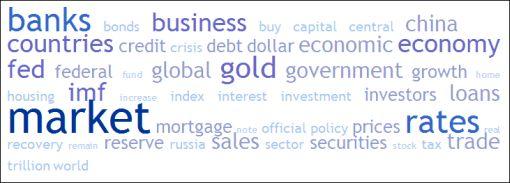
The major moving-average levels for the benchmark US indices, the BRIC countries and South Africa (where I am based) are given in the table below. With the exception of the Shanghai Composite Index, which is trading below its 50-day moving average, all the indices are above their respective 50- and 200-day moving averages. The 50-day lines are also in all instances above the 200-day lines.
The August highs and September lows are also given in the table as these levels define a support area for a number of the indices.
Click here or on the table below for a larger image.
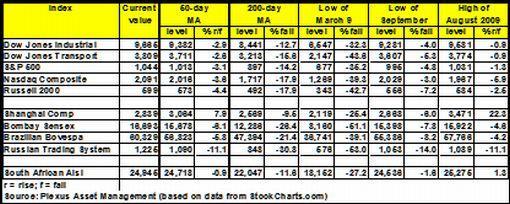
Kevin Lane, technical analyst of Fusion IQ said: “Yesterday’s [Wednesday] intraday sell-the-Fed-news price reversal of the S&P 500 stalled at the area (1,079 to 1,106) where the index really accelerated its 2008 sell-off. While we believe liquidity and buying power remain strong and thus pullbacks should be relatively shallow in nature, it doesn’t mean we can’t get a corrective wave of some magnitude before this sideline liquidity is redeployed. Additionally, quarter-end window dressing may keep stocks elevated or from slipping too much.
“However, we do believe putting new money to work in front of this more significant resistance level poses risks. Initial support below the current S&P levels comes into play near the 1,040 level (current 1,044). Secondary supports if 1,040 were to give way would come into play near 980/975 then 950.”
David Fuller (Fullermoney), making a successful recovery from heart surgery, said: “… it does look as if Wall Street and other stock markets under its influence have temporarily run out of upside momentum following a good run recently. Supply in the form of secondary offerings has increased. This coincides with understandable October jitters as investors recall last year’s meltdown.
“At this stage of the bull market cycle, a consolidation would have the benefit of preventing overheating. When a larger reaction eventually unfolds it is likely to be a providential buying opportunity rather that a repeat of last year’s harrowing decline - provided monetary conditions remain favorable.”
The S&P is at a level that should be reached in the third year of recovery from a recession, David Rosenberg, chief economist of Gluskin Sheff & Associates, told Bloomberg (via MoneyNews). “The fair multiple for earnings should be 12 or 13,” he said. “We’ve blown right through that.” (The S&P 500 is trading at a level equal to almost 20 times reported earnings from continuing operations, according to weekly data compiled by Bloomberg.)
The Bullish Percent Index shows the percentage of stocks that are currently in bullish mode as a result of point-and-figure buy signals. With the figure at 86.4%, this indicator conveys the message that the vast majority of stocks are in uptrends, but the line looks as if it might start turning down from a high level, which could spell at least a short-term top.
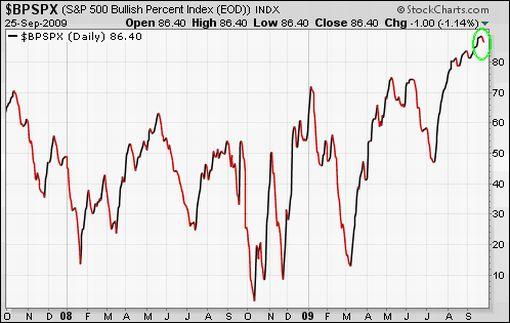
Source: StockCharts.com
As stated often before, share prices have moved too far ahead of economic reality. This calls for a cautious approach in anticipation of the market working off its overbought condition and fundamentals reasserting themselves. I will bide my time while the fundamentals play catch-up, especially as we could be seeing one of those occasional all-change signals in the short-term trends of a number of markets.
For more discussion on the economy and asset classes, see my recent posts “Bonds & equities: Expect a major shift“, “Chart of the Day: Dow Jones vs Monetary Base“, “Marc Faber video bonanza” and “David Rosenberg: Equity market est très expensif“. (And do make a point of listening to Donald Coxe’s webcast of September 25, which can be accessed from the sidebar of the Investment Postcards site.)
Economy
A tentative global economic recovery has begun, according to the results of the latest Survey of Business Confidence of the World by Moody’s Economy.com. “Business expectations are strong that conditions will improve further later this year and early next. Sentiment is strongest in Asia and South America and among business service firms. European businesses and those that work in government are least upbeat. Pricing power is consistent with very low rates of inflation.”
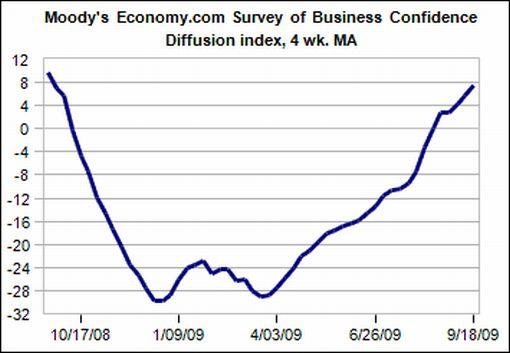
Source: Moody’s Economy.com
The Business Confidence Survey’s results were confirmed by the Duke/CFO Magazine Global Business Outlook Survey of CFOs of 650 companies in the US and nearly 900 in Europe and Asia. According to the Survey, the economic outlook has improved since the last quarter; it appears that the Great Recession is ending and economies around the world are stabilizing. However, the analysis indicates that the recovery will be lethargic, with employment growth lagging behind the rest of the economy.
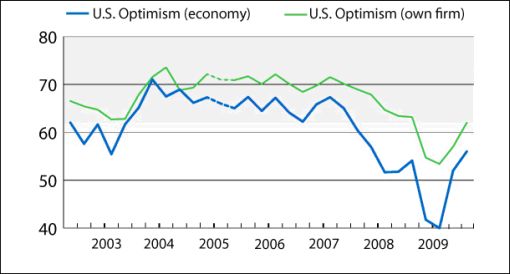
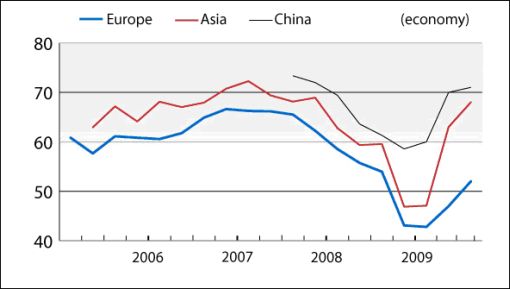
Source: Duke/CFO Magazine Global Business Outlook Survey, September 17, 2009.
As far as hard data are concerned, an index compiled by the Bureau for Economic Policy Analysis, a Dutch research institute, showed the volume of world trade rising by 3.5% in July after a revised increase of 1.6% in June - its fastest rise in more than five years, as reported by the Financial Times.
Also, according to China’s National Bureau of Statistics (via US Global Investors), as of the end of June 97% of the 151 million migrant workers in the country have landed a job, a significant improvement from early this year when more than 20 million migrant workers were reported as being unemployed.
A snapshot of the week’s US economic reports is provided below. (Click on the dates to see Northern Trust’s assessment of the various data releases.)
Friday, September 25
• New homes sales - many encouraging details to report
• Aircraft orders bring down orders of durables in August
Thursday, September 24
• Sales of existing homes are stabilizing, although headline reading fell in August
• Initial jobless claims decline, but tally of unemployment insurance recipients advances
• Surveys point to subdued Eurozone recovery
Wednesday, September 23
• FOMC policy statement - nature of incoming data allows Fed to wait and watch
Monday, September 21
• Index of Leading Economic Indicators - confirms economic recovery is under way
The Fed mentioned in its quarterly flow-of-funds report that American households were $2 trillion richer on June 30 than they had been three months earlier - the first time in two years that household net worth had increased. “Household wealth rose in the second quarter at a 17% annual rate, or $2 trillion, to $53.1 trillion after falling at a 13% rate in the first quarter, the Fed said. It was the first time since the second quarter of 2007 that wealth had increased. Net worth is down $12.2 trillion from the peak in 2007, an indication of how much the collapse in stock prices and home prices has hurt,” said MarketWatch
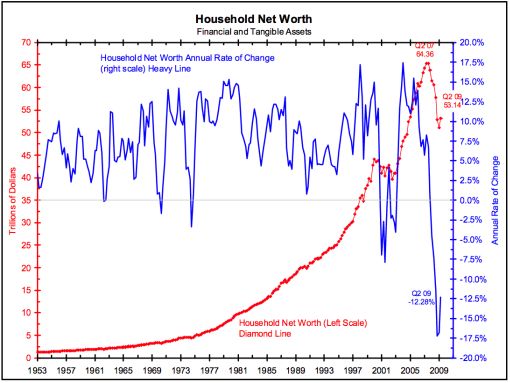
Source: Market Minds (via Bianco Research), September 24, 2009.
On the topic of wealth destruction, the chart below, courtesy of Chart of the Day, not only illustrates that house prices are currently 30% off their 2005 peak, but also that a home buyer who bought a median-priced single-family home at the 1979 peak has seen that home appreciate by a mere 4% over the ensuing three decades.
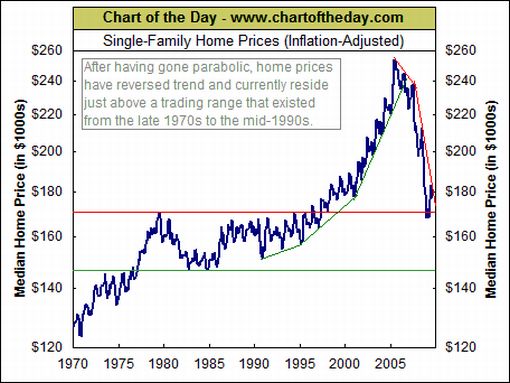
Source: Chart of the Day, September 25, 2009.
The US has lent, spent or guaranteed $11.6 trillion to bolster banks and fight the longest recession in 70 years, according to data compiled by Bloomberg.
“There’s not a lot of new job creation going on on Main Street, and the liquidity to the consumer and to small business is still contracting,” bank analyst Meredith Whitney said on CNBC (via MoneyNews). “It’s very difficult to get the engine moving without a lot of government support within that. So when you slowly wean government support, that’s going to be the test that I think everyone’s going to be watching starting in October.”
Richard Koo, author of Balance Sheet Recession and chief economist at Nomura Research Institute, said in an interview with Kate Welling at Welling@Weeden (via Dow Theory Letters): “In this type of recession, the economy will not enter self-sustaining growth until private sector balance sheets are repaired. Until the private sector is finished repairing its balance sheets, if the government tries to cut its spending, we’re going to fall into the same trap that Franklin Roosevelt fell into in 1937 (a crushing bear market) and Prime Minister Hashimoto fell into in 1997, exactly 70 years later.
“The economy will collapse again and the second collapse is usually far worse than the first collapse. And the reason is that, after the first collapse, people tend to blame themselves. They say, ‘I shouldn’t have played the bubble. I shouldn’t have borrowed money to invest - to speculate on these things.’ But a second collapse affects everyone, not just the bubble speculators, and it also suggests to the public that all the efforts to fight the downturn up to that point - all the monetary easing, the low interest rates, quantitative easing - they all failed and even fiscal policy failed. Once that kind of mindset sets in, it becomes ten times more difficult to get the economy going again.
“So the fact that Larry Summers was talking about ‘temporary’ fiscal stimulus had me very, very worried. That whole Larry Summers idea that one big injection of fiscal stimulus will get the US out of the recession, and everything will be fine thereafter, probably led to President Obama’s saying he’s going to cut his budget deficit in half in four years.”
Click here for a summary of Wells Fargo Securities’ weekly economic and financial commentary.
US economic data reports for the week include the following:
Tuesday, September 29
• Case-Shiller Housing Price Index
• Consumer confidence
Wednesday, September 30
• ADP employment
• GDP - final
• Chicago PMI
Thursday, October 1
• Initial jobless claims
• Personal income and spending
• Construction spending
• ISM Index
• Pending home sales
Friday, October 2
• Employment data
• Factory orders
Markets
The performance chart obtained from the Wall Street Journal Online shows how different global financial markets performed during the past week.
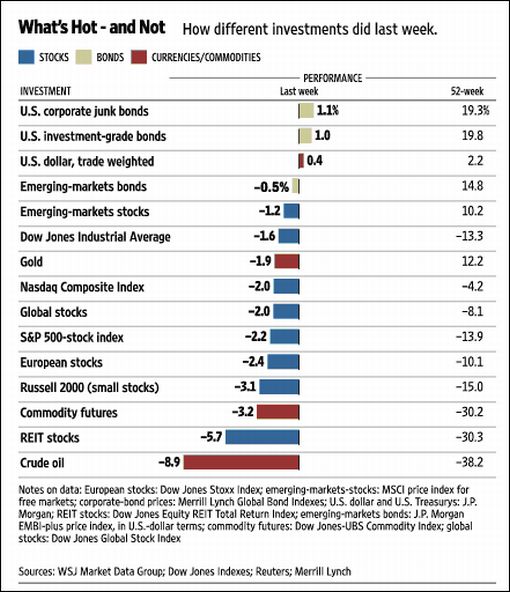
Source: Wall Street Journal Online, September 25, 2009.
“Genius may have its limitations, but stupidity is not thus handicapped,” said Elbert Hubbard, American writer and philosopher (hat tip: Charles Kirk - do make a point of visiting his excellent site). Let’s hope the news items and quotes from market commentators included in the “Words from the Wise” review will assist readers of Investment Postcards to make sensible investment decisions to ensure sold wealth building over time.
For short comments - maximum 140 characters - on topical economic and market issues, web links and graphs, you can also follow me on Twitter by clicking here.
That’s the way it looks from Cape Town (where my bags are almost packed for my first visit to Dallas to attend friend John Mauldin’s 60th birthday celebrations).
Source: Despair (hat tip: The Big Picture)
Bloomberg: G-20 unites again to curb bank pay, align economic policy
“Group of 20 leaders built on the common front they forged in fighting the financial crisis to chart a shared-path toward a more stable banking system and a stronger global economy.
“President Barack Obama and his counterparts ended their Pittsburgh meeting yesterday promising to ‘raise standards together’ to ensure banks restrain pay and build up capital buffers. They also established a peer-review process to monitor individual efforts to rebalance their economies and to hand emerging economies a greater say in managing world growth.
“‘There is much more work to be done, but we leave here today more confident and more united in the common effort of advancing security and prosperity for all of our people,’ Obama told reporters yesterday after hosting his first summit.
“A lot is at stake. While the international economy is showing signs of recovering from its worst recession since World War II, pockets of weakness remain, especially in the US and other industrial countries. Demand for US durable goods unexpectedly fell in August and loans to households and companies in Europe grew at the slowest pace on record, data showed yesterday.
“‘It’s going to be slow going,’ said former US Treasury Secretary Paul O’Neill, who once ran Alcoa Inc., the largest US producer of aluminum, from Pittsburgh and still lives in the city. ‘We’re getting a recovery but it won’t be fast.’
“The third summit of G-20 leaders in the past year plotted a roadmap for revamping the banking industry after the two previous meetings, in Washington and London, focused on fighting market turmoil and reverse the spiral into recession.
“‘Given this is the third meeting of these people in 10 months, the fact that they’ve gotten as much substantively done as they have is quite impressive,’ said Edwin Truman, a former adviser to Obama’s Treasury and a senior fellow at the Peterson Institute for International Economics in Washington.
“After recording $1.6 trillion in losses and writedowns, banks were told to avoid ‘multi-year guaranteed bonuses’ and a ’significant portion of variable compensation’ must be deferred, paid in stock, tied to performance and subjected to clawbacks if earnings flop. The G-20 stopped short of endorsing a French proposal to introduce specific caps on pay.
“Awards must also be curbed if they are “inconsistent with the maintenance of a sound capital base.” Regulators should be allowed to modify the compensation practices of key firms. Banks will also have to increase the quality and quantity of capital they hold by the end of 2012.
“The growing influence of emerging economies such as China and Brazil was marked by the agreement that the G-20 would supplant the G-8 as the guardian of the world economy.”
“The leaders agreed to phase out subsidies for fossil fuels in the ‘medium term,’ without setting a deadline. They also plan to intensify their monitoring of tax havens from next month to ensure economies follow through on promises to comply with global standards.”
Source: Simon Kennedy and Rich Miller, Bloomberg, September 26, 2009.
MoneyNews: Putin - US should scrap trade barriers
“Russian Prime Minister Vladimir Putin on Friday praised President Barack Obama’s decision to scrap plans for a missile defense system in Europe and urged the US to also cancel Cold War-era restrictions on trade with Russia.
“NATO Secretary-General Anders Fogh Rasmussen said the Western alliance and Russia should consider linking their defensive missile systems.
“He said NATO and Russia have a shared interest in combatting the proliferation of intercontinental ballistic missile technology in East Asia and the Middle East.
“‘If North Korea stays nuclear and if Iran becomes nuclear, some of their neighbors might feel compelled to follow their example,’ Fogh Rasmussen said.
“Obama’s predecessor, George W. Bush, had pushed to base elements of a missile defense system in Poland and the Czech Republic, saying it would help defend against a missile attack from Iran. But the Kremlin strenuously objected, fearing that the system would compromise Russia strategic nuclear capabilities or be used to eavesdrop on Russian military forces.
“Russian leaders in the past threatened to deploy short-range missiles to the Baltic exclave of Kaliningrad near Poland if the US moved ahead with the missile defense plan.
“On Friday, the Interfax news quoted an unnamed Russian military-diplomatic source as saying that such retaliatory measures would now be frozen and, possibly, fully canceled in response to Obama’s decision to scrap the missile defense shield.
“Russian president Dmitry Medvedev on Thursday praised the US decision to dump the missile defense plan as a ‘responsible move’.
Source: MoneyNews, September 18, 2009.
Ifo: Business Climate Survey - brighter outlook for Germany
“Appraisals of the business situation and outlook have improved. However, by far the greater number of firms still assesses the business situation as poor. Only with regard to the six-month business outlook is there now nearly a balance between pessimists and optimists. In light of the catastrophic developments over the past twelve months, this is good news.”
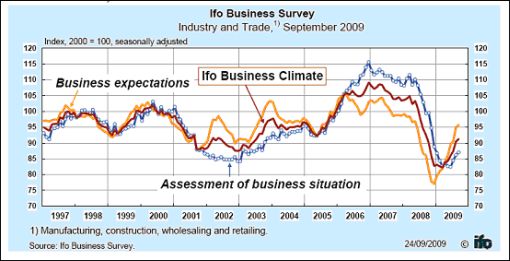
Source: Ifo, September 24, 2009.
Nigel Rendell (RBC Capital Markets): Softly ahead on CEE
“Central and eastern European markets have rallied strongly in the past six months but investors should still proceed with caution, says Nigel Rendell, senior emerging markets strategist at RBC Capital Markets.
“‘As capital has gradually returned to the region - through a combination of IMF rescue packages and portfolio flows - economies have started to show signs of bottoming out,’ he says.
“‘With the backstop of IMF funds for countries in severe financial difficulties, and the promise of precautionary credit lines to others, investors have returned to CEE.’
“But are the markets being too bullish and ignoring potential pitfalls? Mr Rendell outlines three main risks for the region.
“First, sustained recovery is highly dependent on a pick-up in western Europe. ‘Most CEE countries are small, open economies that rely on external demand to create economic growth.’
“Second, fiscal accounts in many CEE countries are in poor shape, with spiralling deficits that will require politically difficult tax rises and spending cuts to meet Maastricht budget criteria.
“Third, the Baltic states and Ukraine are still wild cards, where economic uncertainty and market volatility could feed through to the rest of CEE.
“‘Rather than break long established currency pegs, all three Baltic states have decided to go down the ‘internal devaluation’ route.
“‘We remain very doubtful whether this adjustment can work over the medium term.’”
Source: Nigel Rendell, RBC Capital Markets (via Financial Times), September 21, 2009.
The Wall Street Journal: FOMC - home buyers get a reprieve
“The Federal Reserve, in a move aimed at keeping interest rates low for home buyers through early next year, decided to extend and gradually phase out its purchase of mortgage-backed securities.
“The Fed’s action signals its belief that the economy, while in recovery, remains fragile and that housing, which has seen some improvement in recent months, has only started to pull out of its slump.
“‘We definitely need help from the government,’ says Lee Barrett, president of Century 21 Barrett, a real-estate brokerage firm in Las Vegas. ‘I don’t think the market can make it on its own.’ He also hopes Congress will extend tax credits for home buyers due to expire at the end of November.
“The central bank left its interest-rate target unchanged at zero to 0.25% and maintained its expectation that the federal-funds rate, or the rate banks charge each other for overnight loans, would remain low ‘for an extended period.’
“‘Economic activity has picked up following its severe downturn,’ the Federal Open Market Committee said Wednesday in a statement after a two-day meeting. Though conditions in financial markets and the housing sector have improved, household spending ‘remains constrained by ongoing job losses, sluggish income growth, lower housing wealth and tight credit’, the Fed said.
“The Fed is about two-thirds of the way through its mortgage-purchase program, which was launched late last year to support mortgage lending, housing activity and broader credit markets. The central bank’s decision to complete the full $1.25 trillion in purchases of mortgage-backed securities - rather than ‘up to’ that amount, as it said in August - ended speculation that it might stop short, as a handful of policymakers have suggested. The Fed still plans to buy up to $200 billion in debt issued by Fannie Mae and Freddie Mac.”

Source: Sudeep Reddy and James Hagerty, The Wall Street Journal, September 24, 2009.
Bloomberg: Fed’s strategy reduces US bailout to $11.6 trillion
“The Federal Reserve decided to keep pumping $1.25 trillion of new money into the mortgage market to focus on rescuing the US economy as the financial system revives and banks ask for less help.
“The Fed is allowing some of the 10 support programs it created or expanded after the credit crisis began in August 2007 to expire or shrink. That caused the first decline in the amount of money the US has committed on behalf of taxpayers to end the recession, according to data compiled by Bloomberg.
“The central bank has purchased $694 billion of mortgage- backed securities since January and plans to spend $556 billion more by April 2010 to keep interest rates down. The debt-buying is the biggest program in the Fed’s arsenal.
“‘The first thing the Fed had to do was stop the bleeding in the banking system,’ said Richard Yamarone, director of economic research at Argus Research Corp. in New York. ‘Now that that seems to have been accomplished, they’re focusing on the economy by buying mortgage-backed securities.’
“The purchases were scheduled to stop at the end of December. The Federal Open Market Committee decided on September 23 to continue the program through the first quarter of next year and slow the pace of buying to ‘promote a smooth transition in markets’, the committee said in a statement. It also said the economy has ‘picked up’.
“The US has lent, spent or guaranteed $11.6 trillion to bolster banks and fight the longest recession in 70 years, according to data compiled by Bloomberg. That’s a 9.4% decline since March 31, when Bloomberg last calculated the total at $12.8 trillion.”
MoneyNews: Richard Rahn - the growing debt bomb
“Assume you had put much of your savings into US government bonds and then you learned the following. In just the last eight months, the Congressional Budget Office estimates of the amount of additional federal debt to be held by the public grew by an astounding $4 trillion for the 2010-19 period; and that the amount of federal debt held by the public grew from $5.9 trillion to $7.5 trillion in just the last 12 months.
“In addition, you learned that the federal government (i.e. taxpayers) now owns (primarily through Fannie Mae and Freddie Mac) or insures (through the Federal Housing Administration and other government programs) about 80% of the $14.6 trillion of home mortgages outstanding in the United States. Last week, Congress passed a bill requiring all student loans be made by the federal government rather than banks, which means the taxpayers will be 100% liable for any student loan defaults.
“You also learned that the Federal Deposit Insurance Corp. is considering tapping its Treasury credit line for up to $500 billion. It needs to do this because of the high number of bank failures and because each bank account is insured by the government (i.e. taxpayers) up to $250,000. The president and many in Congress are calling for a roughly $1 trillion health care bill - paid for by additional debt and/or more taxes, which will further slow economic growth, eventually leading to even more debt.
“Finally, you also became aware of the following facts: Federal government expenditures are growing far faster than the economy, and thus the government is becoming a larger and larger share of gross domestic product. Obviously, this cannot continue forever because eventually the government would totally drive out the private sector.
“The entitlement programs (i.e. Social Security, Medicare, Medicaid, etc.) all continue to grow faster than the economy, and they will take more than 100% of all federal tax revenue this year, requiring that virtually all of the other government spending programs, including defense and interest payments on the debt, be funded by more borrowing.
“You are also aware that the government cannot tax its way out of the deficit situation, because increasing income tax rates on the upper income people will both slow the economy and cause them to find legal or illegal ways to avoid the tax increase, and the politicians have pledged to not increase taxes on those making less than $250,000, which includes all but a very few Americans.”
Click here for the full article.
Source: Richard Rahn, MoneyNews, September 22, 2009. (Richard Rahn is a senior fellow at the Cato Institute and chairman of the Institute for Global Economic Growth.)
MoneyNews: Taylor - rates may rise early in 2010
“The Federal Reserve may hike up interest rates to combat inflation as early as the beginning of next year, says Stanford University Professor John Taylor.
“Interest rates have hovered at a very low target range of zero to 0.25% since December, as monetary policymakers have worked to get the country out of the recession.
“Lower lending rates can eventually lead to rising consumer prices.
“The government, meanwhile, has earmarked $787 billion in stimulus spending programs that should inflate the country’s budget deficit, which can also fuel inflation, Taylor told Bloomberg News.
“The Congressional Budget Office predicts the budget deficit will widen to $1.6 trillion this year.
“On top of low interest rates, the Federal Reserve balance sheet has ballooned by $1.2 trillion since the monetary authority bailed out organizations such as insurance giant AIG and took on other assets.
“‘The Fed’s balance sheet has just exploded. They’ve got to find a way to bring it down,’ Taylor said.
“Now, Obama administration officials say, the financial system is on the mend and it’s time for the government to start stepping aside.
“‘The financial system is showing very important signs of repair,’ Treasury Secretary Timothy Geithner said.
“Markets on the mend do not mean that the overall economy is very close to fully healing, he also cautioned.
“‘I would not want anyone to be left with the impression that we’re not still facing really substantial enormous challenges throughout the US financial system.’
“Geithner told Congress this week the government will soon roll back support for Wall Street rescue programs, a move that Taylor applauds.”
Source: Forrest Jones, MoneyNews, September 17, 2009.
Asha Bangalore (Northern Trust): Index of Leading Economic Indicators - confirms economic recovery is underway
“Chairman Bernanke noted last week that a recovery is most likely underway. Our forecast is for a 2.5% increase in real GDP during the third quarter, which is slightly lower than the market consensus. The advance estimate of real GDP for the third quarter will be published on October 29.
“The Index of Leading Economic Indicators rose 0.6% in August, the fifth consecutive monthly increase of the index. On a year-to-year basis, the index moved up 1.89%, the largest gain since May 2006. The July-August average translates to a 1.32% from the third quarter of 2008, the first increase since the first quarter of 2007. Historically, the year-to-year change in the LEI advanced one quarter has a strong positive correlation with the year-to-year change in real GDP.
“This evidence and other economic reports - ISM manufacturing survey, industrial productions index - support expectations that an economic recovery commenced in the third quarter of 2009.
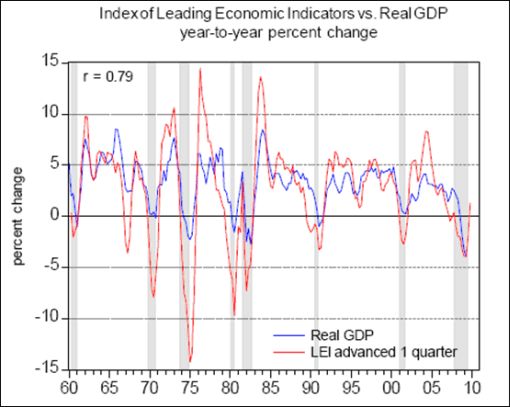
“In August, the workweek held steady, jobless claims, orders of non-defense capital goods and real money supply declined. The remaining seven components - orders of durable consumer goods, supplier deliveries, building permits, interest rate spreads, index of consumer expectations and stock prices moved up. Effectively, there is a widespread improvement in economic conditions, which had been brought about by policy changes. The impact from monetary policy accommodation is evident. The possible impact from the $787 billion fiscal stimulus package will be available in 2010. By the end of fiscal year 2009, roughly 24% of the fiscal package will have been spent.”
Source: Asha Bangalore, Northern Trust - Daily Global Commentary, September 21, 2009.
Asha Bangalore (Northern Trust): Aircraft orders bring down orders of durables
“The 42.2% drop in orders of new civilian aircraft in August after a robust 92.2% increase in the prior month led to the 2.4% drop in orders of durable goods in August vs. a 2.8% jump in July. Primary metals, machinery, and autos recorded gains in orders during August. Bookings of non-defense capital goods excluding aircraft fell 0.4% in August after a 1.3% decline in July.”
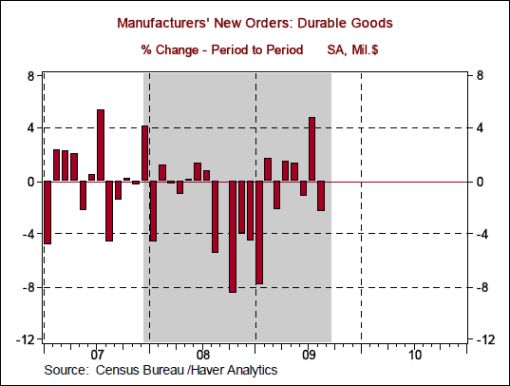
Source: Asha Bangalore, Northern Trust - Daily Global Commentary, September 25, 2009.
Asha Bangalore (Northern Trust): Sales of existing homes are stabilizing
“Sales of all existing homes fell 2.7% to an annual rate of 5.1 million units during August, following a string of four monthly gains. Sales of new single-family homes fell 2.8% to an annual rate of 4.48 million units. The sales level of single-family existing homes is now up 10% from the record low of 4.050 million units in January. In the course of the economic recovery, all economic indicators inclusive of housing measures are likely to show small setbacks than post a straight upward trend.

“I is noteworthy that on a year-to-year basis, sales of all existing homes and single-family homes have risen for three straight months. The Fed’s policy statement on September 23 also pointed to improving conditions in the housing sector. The $8,000 first-time home buyer credit appears to have played a role in bringing about stability in the housing market. The new home sales report for August will be published on September 25.
“The median price of a single-family existing home fell 12.1% from a year ago to $177,500. The largest historical year-to-year drop of the median price of an existing single-family home was recorded in January 2009 (-17.5%)
“The seasonally adjusted inventory-sales ratio of existing single-family homes was an 8.1-month supply in August vs. 8.24-month supply in July. The cycle high reading occurred in November 2008.”
Source: Asha Bangalore, Northern Trust - Daily Global Commentary, September 24, 2009.
Asha Bangalore (Northern Trust): New homes sales - many encouraging details
“Sales of new single-family homes increased slightly in August to an annual rate of 429,000 from 426,000 in July. Sales of new single-family homes have risen 30.4% from the record low of 329,000 units in January 2009.
“The most noteworthy aspect of the report is that sales of new homes held steady in August compared with the sales tally a year ago.
“The median price of a new single-family home stood at $195,700 in August, down 11.7% from a year ago. The largest drop in the median price occurred in February 2009 (-14.5%).
“The inventory of unsold new homes fell to 7.3-month supply in August vs. 7.6-month supply in July. The median inventory of unsold homes during 1963-2001 is 6-month supply. The $8,000 first-time home buyer tax credit and low mortgage rates have helped to stabilize sales of homes.”
Source: Asha Bangalore, Northern Trust - Daily Global Commentary, September 25, 2009.
Eoin Treacy (Fullermoney): US Homebuilding Index leads Case/Shiller
“The overlay of the S&P500 Homebuilding Index with the Case/Shiller Composite-10 Index shows the sector topping out almost a year ahead of house prices. The sector lost downward momentum from January 2008 and has arguably been in a period of base formation since. It hit an important low in November, posted a consistent succession of higher reaction lows since and pushed above the 200-day moving average which has now also turned upwards.
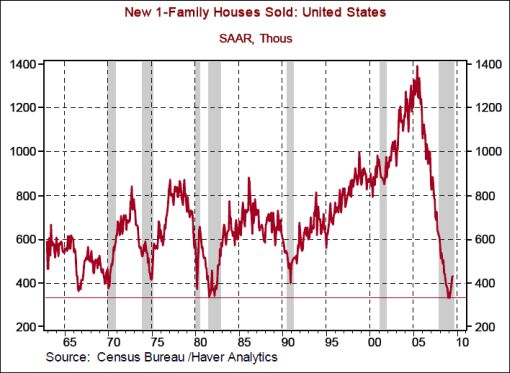
“Given the sector’s lead over the Case/Shiller Index, it is plausible to assume that house prices have begun to bottom out. However, this is also likely to a lengthy process.”
Source: Eoin Treacy, Fullermoney, September 23, 2009.
Bloomberg: Housing crash to resume on 7 million foreclosures
“The crash in US home prices will probably resume because about 7 million properties that are likely to be seized by lenders have yet to hit the market, Amherst Securities Group analysts said.
“The ‘huge shadow inventory’, reflecting mortgages already being foreclosed upon or now delinquent and likely to be, compares with 1.27 million in 2005, the analysts led by Laurie Goodman wrote today in a report. Assuming no other homes are on the market, it would take 1.35 years to sell the properties based on the current pace of existing-home sales, they said.
“Helping to stoke speculation the housing slump has ended, an S&P/Case-Shiller Index for 20 US metropolitan areas showed the first month-over-month increases in values since 2006 in May and June, reducing the drop from the peak to 31%. Echoing other mortgage-bond analysts including those at Barclays Capital, Amherst cautioned that a change in the mix of foreclosure and traditional sales over different parts of the year lifted prices in the period, as the distressed share shrank.
“‘The favorable seasonals will disappear over the coming months, and the reality of a 7 million-unit housing overhang is likely to set in,’ they said.
“The amount of pending foreclosed-home supply has been boosted by more borrowers going into default, fewer being able to catch up once they do, and longer time periods to seize properties because of issues such as loan-modification efforts and changes to state laws, the New York-based analysts wrote.”
Source: Jody Shenn, Bloomberg, September 23, 2009.
Chart of the Day (Clusterstock): The Option ARM Armageddon
“The Option Arm Armageddon was supposed to strike in the spring of 2009. Across the country, option adjustable-rate mortgages (ARMs) were set to detonate and start a new wave of foreclosures.
“But it never happened. We made it well past when this chart from Credit Suisse showed the option ARMs were supposed to begin to hit. And the crisis didn’t come.
“Why not? Well, when interest rates dropped to historically low levels as the Fed fought the financial crisis, the wave of resets was held off. Unfortunately, low interest rates won’t last forever - they’ll now likely strike next year and continue well into 2011. Many borrowers who now have the option of making payments so low that they don’t even cover the interest are seeing their original loan balance grow, even as their home values continue to fall or remain flat.
“The chart below shows that the option ARM reset problem is comparable to the subprime problem, and will likely last for quite some time. Armageddon may have been forestalled but it hasn’t been overcome.”
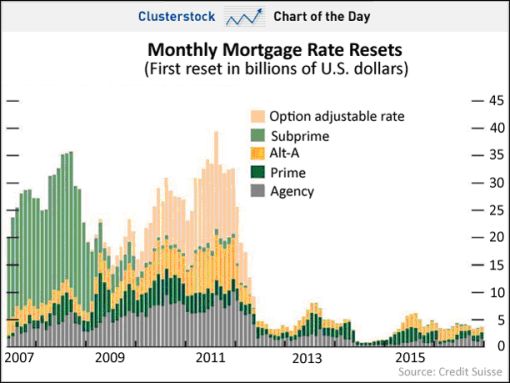
Source: John Carney and Kamelia Angelova, Clusterstock - Business Insider, September 21, 2009.
The Huffington Post: Landmark decision promises massive relief for homeowners and trouble for banks
“A landmark ruling in a recent Kansas Supreme Court case may have given millions of distressed homeowners the legal wedge they need to avoid foreclosure. In Landmark National Bank v. Kesler, 2009 Kan. LEXIS 834, the Kansas Supreme Court held that a nominee company called MERS has no right or standing to bring an action for foreclosure. MERS is an acronym for Mortgage Electronic Registration Systems, a private company that registers mortgages electronically and tracks changes in ownership.
“The significance of the holding is that if MERS has no standing to foreclose, then nobody has standing to foreclose - on 60 million mortgages. That is the number of American mortgages currently reported to be held by MERS. Over half of all new US residential mortgage loans are registered with MERS and recorded in its name. Holdings of the Kansas Supreme Court are not binding on the rest of the country, but they are dicta of which other courts take note; and the reasoning behind the decision is sound.
“The development of ‘electronic’ mortgages managed by MERS went hand in hand with the ’securitization’ of mortgage loans - chopping them into pieces and selling them off to investors. In the heyday of mortgage securitizations, before investors got wise to their risks, lenders would slice up loans, bundle them into ‘financial products’ called ‘collateralized debt obligations’ (CDOs), ostensibly insure them against default by wrapping them in derivatives called ‘credit default swaps’, and sell them to pension funds, municipal funds, foreign investment funds, and so forth.
“There were many secured parties, and the pieces kept changing hands; but MERS supposedly kept track of all these changes electronically. MERS would register and record mortgage loans in its name, and it would bring foreclosure actions in its name. MERS not only facilitated the rapid turnover of mortgages and mortgage-backed securities, but it has served as a sort of ‘corporate shield’ that protects investors from claims by borrowers concerning predatory lending practices.”
Click here for the full article.
Source: The Huffington Post, September 25, 2009.
Bloomberg: Card defaults surge in August
“US credit-card defaults rose to a record in August and more losses may lie ahead as delinquencies climbed for the first time since March, according to Moody’s Investors Service.
“Write-offs rose to 11.49% from 10.52% in July, Moody’s said today in a report. Loans at least 30 days delinquent rose to 5.8% from 5.73%. ‘Early- stage’ delinquencies, or loans overdue 30 to 59 days, surged to 1.65%, from 1.41%, signaling higher losses in coming months. Banks typically write off loans after 180 days.
“Card issuers have struggled with rising defaults as the recession drove up unemployment to 9.7% and the impact of income tax refunds waned. Credit-card defaults typically track the US jobless rate since consumers tend to fall behind on payments when their income dries up.
“‘We continue to call for a recovery of the credit-card sector to begin once industry average charge-offs peak in mid-2010 between 12% and 13%,” said the Moody’s report, which predicted unemployment may reach 10.5%.”
Source: Peter Eichenbaum, Bloomberg, September 23, 2009.
MoneyNews: Wave of commercial property defaults ahead
“Once flourishing commercial property sales are expected to hit their lowest point in almost two decades this year, and analysts say the growing loan default rate may significantly lower gains in real estate investment shares.
“‘There’s no real way to sugarcoat it,’ Real Capital Analytics managing director Dan Fasulo told Bloomberg.
“‘A slowdown of this magnitude certainly hasn’t occurred since I’ve been in the business.’
“‘Some of the older folks in the industry I talk to said it has a similar feel to the early ’90s, when transaction activity went to basically zero.’
“The volume of office sales in the second quarter was 97% less than the market’s peak in the first three months of 2007, according to Real Capital, whose data indicates that only about $16 billion of sales for office buildings will complete by year’s end.
“Moreover, fewer transactions make it more difficult for buyers and sellers to agree on prices, which in turn makes lenders less able to find the comparable transactions they need in order to evaluate loan worthiness.
“Returns on office investments this year have been running almost 1% higher than for moderate-risk long-term corporate bonds.
“Most commercial property mortgages made within the last few years are headed for default, says real estate financier Ethan Penner.
“‘For anything originated after 2005, the chances of those loans going into default are very high,’ Penner told The Dallas Morning News.
“‘A large majority of the loans originated in this period will ultimately go into default.’”
Source: Julie Crawshaw, MoneyNews, September 17, 2009.
Financial Times: European property groups face debt time-bomb
“European commercial property owners face a wave of complex debt refinancings and restructurings that pose a threat to the sector, according to bankers and industry groups.
“Senior bankers and industry representatives in the UK used a meeting with the Bank of England in the summer to highlight the problems caused by billions of pounds worth of debt that needs to be refinanced or has breached banking agreements.
“They are particularly concerned about the amount of European debt packaged in complex bonds, known as commercial mortgage-backed securities (CMBS), where restructuring has proved especially difficult and highlighted this issue to the Bank for the first time.
“The group, which includes senior bankers and representatives from the British Property Federation, the Royal Institution of Chartered Surveyors and the Investment Property Forum, believes the CMBS market remains important to the property sector.
“It discussed with the Bank whether a central bank guarantee could be used to underpin the debt issued, or whether the real estate investment trust market could be used by banks to offload their loans.
“There is mounting concern among industry professionals about how to restructure or refinance the $2,100 billion of European commercial property loans, in particular the $200 billion in CMBS.
“A report from the UK industry group that met with the Bank highlighted that the UK commercial property sector could be in negative equity until 2017 and undercapitalised by up to £120 billion ($195 billion) based on current conservative banking refinancing terms.
“Close to £43 billion of loans to the commercial property sector are due for repayment this year alone, according to De Montfort University research.
“Half of the outstanding European CMBS market needs to be repaid in 2011 and 2012, and CMBS in default have already proved difficult to restructure.
“‘The amount of outstanding CMBS that need to be refinanced poses an absolutely huge problem, which is waiting to hit the market,’ said Edmund O’Kelly, head of real estate restructuring at KPMG. ‘A lot of the technology for creating the structures was imported from the US, but they have never been tested in Europe. Restructuring CMBS is unchartered territory.’”
Source: Anousha Sakoui and Daniel Thomas, Financial Times, September 20, 2009.
Bespoke: Investors get back $18.31 trilion
“Below we highlight the total market capitalization of stocks both globally and in the US. At its peak in 2007, total world market cap was $62.57 trillion. By the lows this March, world market cap had dropped to $25.6 trillion! That’s a loss of $36.97 trillion in stocks globally. Since the March lows, however, world market cap has risen $18.31 trillion back up to $43.9 trillion.
“In the US, market cap has risen $4.88 trillion from its low of $8.09 trillion in March. The peak in total US stock market value was $19.14 trillion in 2007, and the current value of all US stocks is $12.97 trillion. The US accounts for 29.5% of total stock market value in the world.”
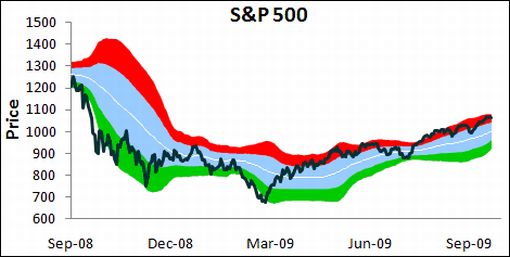

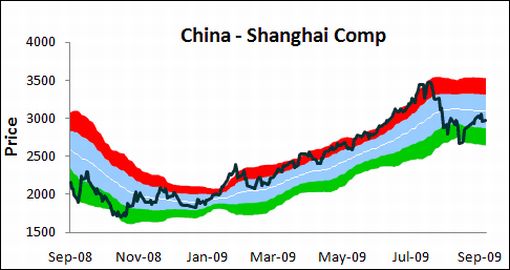
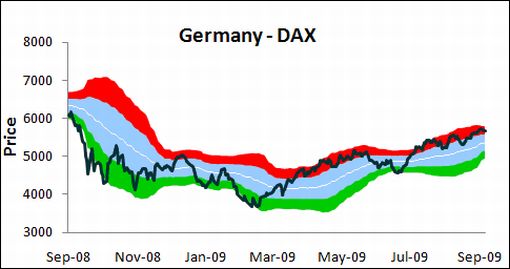
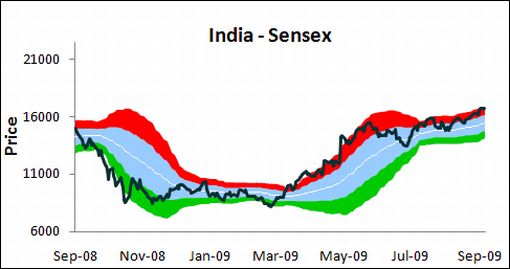
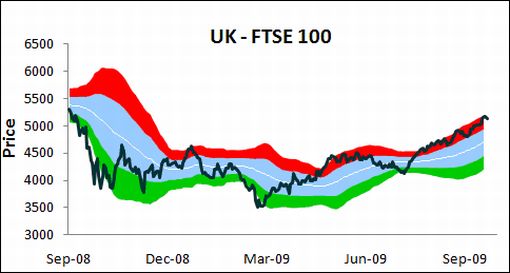
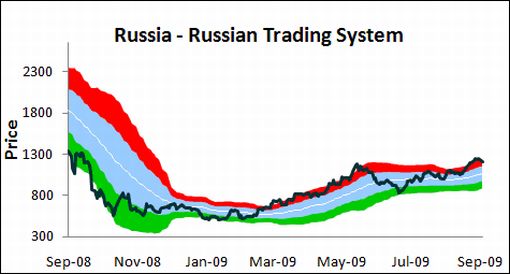
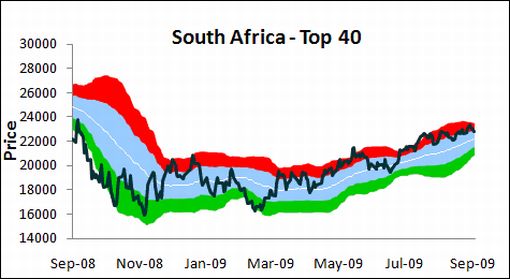
Source: Bespoke, September 21, 2009.
By Dr Prieur du Plessis
Dr Prieur du Plessis is an investment professional with 25 years' experience in investment research and portfolio management.
More than 1200 of his articles on investment-related topics have been published in various regular newspaper, journal and Internet columns (including his blog, Investment Postcards from Cape Town : www.investmentpostcards.com ). He has also published a book, Financial Basics: Investment.
Prieur is chairman and principal shareholder of South African-based Plexus Asset Management , which he founded in 1995. The group conducts investment management, investment consulting, private equity and real estate activities in South Africa and other African countries.
Plexus is the South African partner of John Mauldin , Dallas-based author of the popular Thoughts from the Frontline newsletter, and also has an exclusive licensing agreement with California-based Research Affiliates for managing and distributing its enhanced Fundamental Index™ methodology in the Pan-African area.
Prieur is 53 years old and live with his wife, television producer and presenter Isabel Verwey, and two children in Cape Town , South Africa . His leisure activities include long-distance running, traveling, reading and motor-cycling.
Copyright © 2009 by Prieur du Plessis - All rights reserved.
Disclaimer: The above is a matter of opinion and is not intended as investment advice. Information and analysis above are derived from sources and utilizing methods believed reliable, but we cannot accept responsibility for any trading losses you may incur as a result of this analysis. Do your own due diligence.
Prieur du Plessis Archive |
© 2005-2022 http://www.MarketOracle.co.uk - The Market Oracle is a FREE Daily Financial Markets Analysis & Forecasting online publication.




